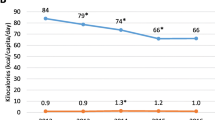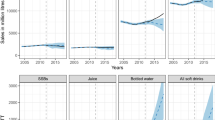Abstract
Since 2006, New York City (NYC) has attempted to reduce sugary drink consumption through several population-based initiatives, media campaigns and policy proposals. We estimated trends in the relative market share of sugary drinks and other beverage categories in NYC, using over 5 years of weekly, point-of-sale data from a retailer sample. We used an interrupted time series approach to assess whether changes in NYC beverage purchasing patterns occurred following the announcement of a proposed portion cap rule for consumer purchases of sugary drinks. Overall, market share of sugary drinks declined in NYC between 2010 and 2015. While the proportion of beverage volume sold that was sugary drinks was stable prior to the May 2012 portion cap rule announcement, decreases of 1.25% per year were observed in the period following the announcement compared to the period before (95% confidence interval (CI) − 1.60, − 0.90). Water/seltzer market share was increasing prior to the announcement and increased by an additional 1.03% per year in the post-announcement period (95% CI 0.48, 1.57). City-led efforts to increase public awareness about sugary drink-associated health risks in NYC may have led to reductions in consumer purchases of these beverages. Though never implemented, the portion cap proposal and accompanying media coverage may have contributed to decreases in sugary drink sales.


Similar content being viewed by others
References
Malik, V. S., Pan, A., Willett, W. C., et al. (2013). Sugar-sweetened beverages and weight gain in children and adults: A systematic review and meta-analysis. American Journal of Clinical Nutrition, 98(4), 1084–1102.
Bernabe, E., Vehkalahti, M. M., Sheiham, A., et al. (2014). Sugar-sweetened beverages and dental caries in adults: A 4-year prospective study. Journal of Dentistry, 42, 952–958.
Schulze, M. B., Manson, J. E., Ludwig, D. S., et al. (2004). Sugar-sweetened beverages, weight gain, and incidence of type 2 diabetes in young and middle-aged women. JAMA, 292, 927–934.
Fung, T. T., Malik, V., Rexrode, K. M., et al. (2009). Sweetened beverage consumption and risk of coronary heart disease in women. American Journal of Clinical Nutrition, 89, 1037–1042.
U.S. Department of Health and Human Services and U.S. Department of Agriculture. 2015–2020 Dietary Guidelines for Americans. 8th Edition. December 2015. Retrieved from https://health.gov/dietaryguidelines/2015/guidelines/. Accessed 31 January 2020.
Elfassy, T., Adjoian, T., & Lent, M. (2019). Sugary drink consumption among NYC children, youth, and adults: Disparities persist over time, 2007–2015. Journal of Community Health, 44, 297–306.
Harris, J. L., Schwartz, M. B., LoDolce, M., et al. Sugary Drink FACTS 2014: Some progress but much room for improvement in marketing to youth. Rudd Center for Food Policy and Obesity, Yale University. Retrieved March 24, 2018, from https://www.sugarydrinkfacts.org/resources/SugaryDrinkFACTS_Report.pdf.
Powell, L. M., Wada, R., & Kumanyika, S. K. (2014). Racial/ethnic and income disparities in child and adolescent exposure to food and beverage television ads across the U.S. media markets. Health Place, 29, 124–131.
Kansangra, S. M., Kennelly, M. O., Nonas, C. A., et al. (2015). Reducing sugary drink consumption: New York City’s approach. American Journal of Public Health, 105, e61–e64.
New York Statewide Coalition of Hispanic Chambers of Commerce v. the New York City Department of Health and Mental Hygiene, 23 N.Y.3d 681 (2014).
Donaldson, E. A., Cohen, J. E., Truant, P. L., et al. (2015). News media framing of New York City’s sugar-sweetened beverage portion-size cap. American Journal of Public Health, 105, 2202–2209.
Grynbaum, M. Soda makers begin their push against New York Ban. The New York Times. July 1, 2012:A10. Retrieved June 5, 2018, from https://archive.nytimes.com/www.nytimes.com/2012/07/02/nyregion/in-fight-against-nyc-soda-ban-industry-focuses-on-personal-choice.html.
Wagner, A. K., Soumerai, S. B., Zhang, F., et al. (2002). Segmented regression analysis of interrupted time series studies in medication use research. Journal of Clinical Pharmacy and Therapeutics, 27, 299–309.
Penfold, R. B., & Zang, F. (2013). Use of interrupted time series analysis in evaluating health care quality improvements. Academic Pediatrics, 13, S38–44.
SAS Institute Inc. 2014. SAS/ETS® 13.2 User’s Guide: The AUTOREG Procedure. Cary, NC: SAS Institute Inc. (2014). Retrieved January 5, 2020, form https://support.sas.com/documentation/onlinedoc/ets/132/autoreg.pdf.
Kipnis, V., Subar, A. F., Midthune, D., et al. (2003). Structure of dietary measurement error: Results of the OPEN biomarker study. American Journal of Epidemiology, 158, 14–21.
Silver, L. D., Ng, S. W., Ryan-Ibarra, S., et al. (2017). Changes in prices, sales, consumer spending, and beverage consumption one year after a tax on sugar-sweetened beverages in Berkeley, California, US: A before-and-after study. PLoS Medicine, 14, e1002283.
Roberto, C. A., Lawman, H. G., LeVasseur, M. T., et al. (2019). Association of a beverage tax on sugar-sweetened beverages with changes in beverage prices and sales at chain retailers in a large urban setting. JAMA, 321, 1799–1810.
Schwartz, M. B., Schneider, G. E., Choi, Y. Y., et al. (2017). Association of a community campaighn for better beverage choices with beverage purchases from supermarkets. JAMA Internal Medicine, 177, 666–674.
Niederdeppe, J., Gollust, S. E., Jarlenski, M. P., et al. (2013). News coverage of sugar-sweetened beverage taxes: Pro- and antitax arguments in public discourse. American Journal of Public Health, 103, e92–e98.
Matthews, A., Herret, E., Gasparrini, A., et al. (2016). Impact of statin related media coverage on use of statins: Interrupted time series analysis with UK primary care data. BMJ, 353, i3283.
Kelaher, M., Cawson, J., Miller, J., et al. (2008). Use of breast cancer screening and treatment services by Australian women aged 25–44 years following Kylie Minogue’s breast cancer diagnosis. International Journal of Epidemiology, 37, 1326–1332.
Desai, S., & Jena, A. B. (2016). Do celebrity endorsements matter? Observational study of BRCA gene testing and mastectomy rates after Angelina Jolie’s New York Times editorial. BMJ, 355, i6357.
Farley, T., Halper, H. S., Carlin, A. M., et al. (2017). Mass media campaign to reduce consumption of sugar-sweetened beverages in a rural area of the United States. American Journal of Public Health, 107, 989–995.
Gollust, S. E., Fowler, E. F., & Niedereppe, J. (2019). Television news coverage of public health issues and implications for public health policy and practice. Annual Review of Public Health, 40, 167–185.
Pew Research Center. Local TV News Media Fact Sheet. Retrieved July 23, 2019, from https://www.journalism.org/fact-sheet/local-tv-news/.
Bleich, S. N., Vercammen, K. A., Koma, J. W., et al. (2017). Trends in beverage consumption among children and adults, 2003–2014. Obesity (Silver Spring, MD), 26, 432–441.
Lopez Bernal, J., Cummins, S., & Gasparrini, A. (2018). The use of controls in interrupted time series studies of public health interventions. International Journal of Epidemiology, 47, 2082–2093.
Horowitz, C. R., Colson, K. A., Hebert, P. L., et al. (2004). Barriers to buying healthy foods for people with diabetes: Evidence of environmental disparities. American Journal of Public Health, 94, 1549–1554.
Bailey, Z. D., Krieger, N., Agénor, M., et al. (2017). Structural racism and health inequities in the USA: Evidence and interventions. The Lancet, 389, 1453–1463.
O’Connor, A., Sanger-Katz, M. California, of all places, has banned soda taxes. How a new industry strategy is succeeding. The New York Times. June 27, 2018. Retrieved February 5, 2020, from https://www.nytimes.com/2018/06/27/upshot/california-banning-soda-taxes-a-new-industry-strategy-is-stunning-some-lawmakers.html.
Bes-Rastrollo, M., Schulze, M. B., Ruiz-Canela, M., et al. (2013). Financial conflicts of interest and reporting bias regarding the association between sugar-sweetened beverages and weight gain: A systematic review of systematic reviews. PLoS Medicine, 10, e1001578.
Funding
This research received no specific grant from any funding agency, commercial or not-for-profit sectors.
Author information
Authors and Affiliations
Contributions
SF conceived and supervised analysis; JS conceived and conducted analyses and assisted with writing; TA prepared the manuscript; AA assisted with writing. All authors edited initial drafts, and read and approved the final manuscript.
Corresponding author
Ethics declarations
Conflict of interest
None.
Ethical Approval
Neither informed consent nor IRB approval were required for this study, as no human participants were involved.
Additional information
Publisher's Note
Springer Nature remains neutral with regard to jurisdictional claims in published maps and institutional affiliations.
Electronic supplementary material
Below is the link to the electronic supplementary material.
Rights and permissions
About this article
Cite this article
Sisti, J.S., Mezzacca, T.A., Anekwe, A. et al. Examining Trends in Beverage Sales in New York City During Comprehensive Efforts to Reduce Sugary Drink Consumption, 2010–2015. J Community Health 46, 609–617 (2021). https://doi.org/10.1007/s10900-020-00911-y
Published:
Issue Date:
DOI: https://doi.org/10.1007/s10900-020-00911-y




